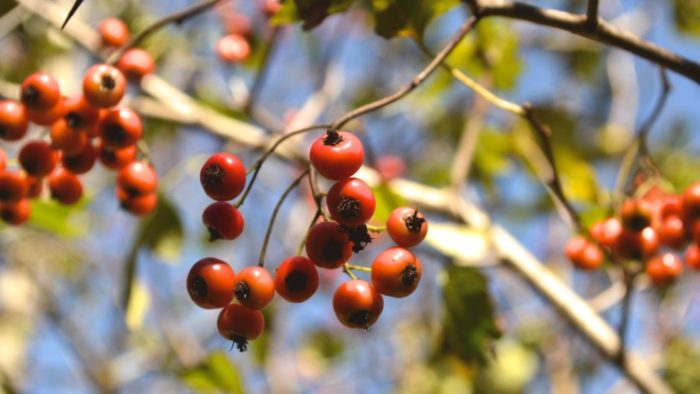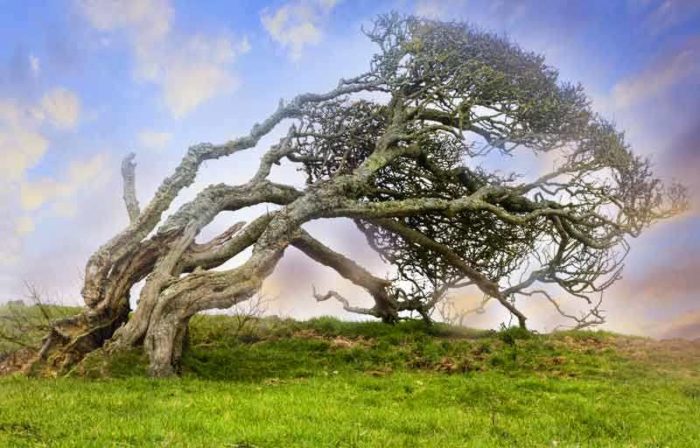Hawthorn Tree Symbolism – A Very Special Tree
Hawthorn tree symbolism has a long history in the Celtic, Greek, and Druid traditions.
It also features heavily in modern Druidic practice, as it has culturally across Europe and the Mediterranean, particularly in festivals welcoming the arrival of summer.
The Hawthorn is a deciduous tree with thorny branches and lobed or serrated leaves growing on long shoots.
They blossom around the start of summer when they present their berry-like “pome” inside a (commonly) white flower.
The thorny branches are perfect for many species of birds that use them as materials for building their nests.
The berries are also a common source of food for many avian species.
Traditional medicine has long made use of its healing properties. Various teas, brews, and concoctions made from the bark, leaves, and berries have been used to treat symptoms of the common cold.
Some topical mixtures have been used to treat skin problems.
The most powerful Hawthorn tree symbolism surrounds ideas of love, healing, resistance to disease, beauty, romance, fertility, and balance in duality.
Love Symbolism
Although the majority of the history of the symbolism of this tree is found within the tradition of the Celts, the earliest occurrences of myths related to it originate with the Greeks.
To them, the Hawthorn (and related species) were symbolic of love and would help bring success and longevity to newlyweds.
It was a tradition across much of the Greek world, including in Rome, Macedon, and much of the Mediterranean, to present a newly married couple with branches of trees like this one.
This was believed to bless the couple in the eyes of the powerful natural gods.
As is so often the case with the beliefs and practices of the Ancient Greeks, there was renewed interest in this particular practice during the Renaissance.
It is here that the Hawthorn probably gained more popularity in this kind of practice because it is a far more common species across western and northern Europe.
If you have recently married or moved in with your partner, then you could adorn your walls with cuttings from a blossoming Hawthorn.
This will bring your relationship to a level of protection from harm, as well as provide a lovely scent for your living space.
The best time to do this is around the middle of May in the northern hemisphere, around the middle of November in the southern hemisphere.
Not only is this the time when it blossoms (and therefore looks and smells the best), but you will also avoid incurring the wrath of the fairies, to whom the tree is sacred.
Beauty Symbolism
Celtic Hawthorn tree symbolism emphasizes beauty, among other things.
During Beltane – the Celtic festival to welcome the summer – Hawthorn trees and bushes play a central role.
They were decorated with ornaments, and the branches braided in intricate patterns, with whole towns and villages coming together to do so.
This was especially common in Ireland, where this ritual influenced the later introduction of tree decorations at Christmas.
The reason that the Hawthorn was used in particular – aside from being so common was the beauty of the blossom and berry.
Although thorny branches are not often associated with beauty, the fact that the leaves tend to cover the thorns tends to make up for it.
Protection Symbolism
The Hawthorn is also a powerful symbol of protection from harm, evil forces, and disease.
The thorns that grow on the branches help to keep it free from damage caused by large insects and animals – including humans.
Large animals that might otherwise feed on the leaves, twigs, and sap are kept away by the promise of pain.
In fact, few animals are able to feed from it at all other than during the blossom when the berries are revealed.
Branches from the Hawthorn have long been used as a symbol of protection, hung above doorways, and pinned to walls as a way to ward off the evil spirits.
The scent of the sap and foliage has a distinct aroma that is thought to have a cleansing effect on the energy of a room.
Drinking teas and other herbal remedies from Hawthorn ingredients have traditional medicinal qualities.
They were said to help fight off infection, induce a relaxing sleep, and keep illnesses like the common cold at bay.
Today we would say that it helps to boost the immune system, though, during its most common usage period, people had no idea about this concept.
Fertility Symbolism
Perhaps the most enduring symbolic use of the Hawthorn is in fertility rites.
This is one thing the Greeks and the Celts agreed upon – the fertility of a newlywed couple could be boosted by the timely and proper use of this sacred tree.
In the Celtic tradition, it was associated with the summer festival, a time of abundance when the natural world showed its vitality through reproduction.
The blossoming of the Hawthorn was central to this process for those in Europe, with the petals opening to reveal the berries being symbolic of increased fertility and readiness to reproduce.
While it was common in Greece to present branches to the newlyweds in order to increase fertility and bless them under the eyes of their natural gods.
However in the Celtic tradition, it was a little different – and involved a lot more heat.
The collected branches were often burned in a pile, the flame being symbolic of passion, vitality, and pleasure.
The idea of bonfires as part of festivals across the world may have come from this practice as it evolved over time.
If you are hoping to start a family and want to boost your chances of conceiving in a timely manner, it could be beneficial for you to collect some Hawthorn branches, twigs, and leaves to burn in a bonfire.
If you prefer the Greek tradition, you might instead crush the leaves and berries for the aroma, which is commonly thought to be an aphrodisiac.
It is possible to get this scent in the form of candles and incense.








Thank you so much for writing this article. It is full of info I didn’t know, utterly fascinating. I moved into my new home last year and I have a beautiful mature Hawthorne. I never knew they grew so big. I had a hunch it was a tree of protection so went looking and found your site straight away. I’m off to read your other articles. I wish you had a like button ♥️